
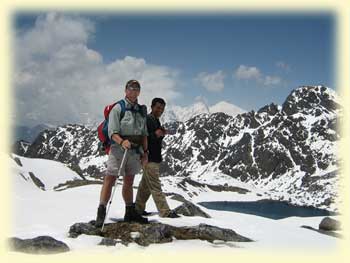
Friday 28th April 2006
Trek Day 5
Phedi to Gosainkund
Over the top
We have our early night, but after five or six hours sleep, I
lay awake, tossing and turning. I need to take a pee, so I dash
out of the tent into the cold night, wearing only my underpants
and boots. This is our favourite strategy for night time excursions.
If you get dressed to go out, then by the time you get undressed
and back into your sleeping bag, it is usually cold and so are you.
If you make a quick dash, then the whole operation is over in a
few minutes, and you and your sleeping bag stay warm. I've done
this in very cold conditions, but I admit that if it gets too cold
I resort to using a pee bottle.
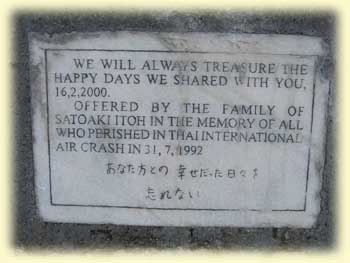 After
a breakfast of delicious apple fritters, and coffee, we make an
early start; getting away by 7am. As we reach the lodge higher up
on the moraine, we see a chorten with a plaque commemorating those
that died in the Airbus crash, that I mentioned earlier. It looks
like the chorten and plaque were place here by relatives of one
of the victims. They must have visited the spot because they talk
about the hospitality and friendship they've received from the local
people here in Nepal. After
a breakfast of delicious apple fritters, and coffee, we make an
early start; getting away by 7am. As we reach the lodge higher up
on the moraine, we see a chorten with a plaque commemorating those
that died in the Airbus crash, that I mentioned earlier. It looks
like the chorten and plaque were place here by relatives of one
of the victims. They must have visited the spot because they talk
about the hospitality and friendship they've received from the local
people here in Nepal.
We turn our attention to the slope ahead of us, and it looks an
awfully long way to climb. The Fins and the Israelis must still
be in bed or having breakfast, because there's no sign of anyone
ahead and the path is still covered in virgin snow from the day
before. We set off and make good progress because the snow is frozen
solid and we can walk on the surface without sinking in.
For the first time on this trek, I'm wearing long trousers. I've
got on a long-sleeved silk vest under a long sleeved synthetic shirt.
I've got a fleece hat, and a stretch tube thing which acts like
a scarf to protect my neck. I'm wearing dark wraparound sunglasses,
and thin silk gloves. In our sacks we have extra warm clothing in
case the weather turns nasty. We've had plenty of experience and
know how quickly conditions can change. Cold windy conditions shouldn't
be a problem for us.
The sun gets higher and hotter in a cloudless sky, and I start
to get very warm. I need to keep covered up because the sun is behind
us and it would burn my neck and legs. Also, because we are walking
on pure white snow, the sun is reflecting up onto our faces making
it very hot and uncomfortable. It's difficult to think straight
when climbing hard at altitude, and I completely forget to put sunscreen
on my face. Even though there's no direct sun and my face is already
tanned, I can feel my skin getting burned. It's like that burning
feeling you get when you sit too close to a blazing bonfire, and
I'm too exhausted to do anything sensible about it! All I do is
grab handfuls of snow, and rub it over my face to cool it down.
The relief only lasts for a few minutes.
 As
the day gets warmer the frozen crust softens, and we start to break
through the surface. We constantly plunge up to our thighs in snow,
making it difficult to maintain a steady pace. Because we are barely
acclimatized to the altitude, all this floundering about soon has
us gasping for air, and slows our progress to a snails pace. You
really need to maintain a steady pace and keep control of your breathing.
Each time I break through the crust, I'm left gasping for air and
have to wait until I've got my breath back. As
the day gets warmer the frozen crust softens, and we start to break
through the surface. We constantly plunge up to our thighs in snow,
making it difficult to maintain a steady pace. Because we are barely
acclimatized to the altitude, all this floundering about soon has
us gasping for air, and slows our progress to a snails pace. You
really need to maintain a steady pace and keep control of your breathing.
Each time I break through the crust, I'm left gasping for air and
have to wait until I've got my breath back.
Once the altitude starts to affect you, simple tasks like packing
a sleeping bag, or even tying your boot laces, can make you breathless.
If we were going to stay at altitude, or climb even higher, then
we'd plan on taking a rest-day, to allow our bodies to catch up,
and get used to the rarefied atmosphere. Once properly acclimatised,
you feel more comfortable climbing, and you don't get out of breath
so easily. As it is, we'll be descending after the pass, so there's
little point in taking extra time to acclimatise, especially as
we have no more serious symptoms of altitude sickness. We'll just
have to put up with it, and go slowly.
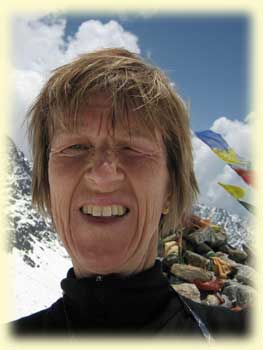 Amazingly,
half-way up the slope, we come upon a tea-house where we take a
rest and have a cup of tea. We look back with satisfaction as we
see how far we've climbed. There is just one man running this tea-house.
He has Tibetan features, his face is almost black from the sun,
and his eyes are hidden behind enormous aviator style sunglasses.
He sits outside with us and talks with Nurbu. I'm sure he's glad
of the company as well as the income from the drinks. Amazingly,
half-way up the slope, we come upon a tea-house where we take a
rest and have a cup of tea. We look back with satisfaction as we
see how far we've climbed. There is just one man running this tea-house.
He has Tibetan features, his face is almost black from the sun,
and his eyes are hidden behind enormous aviator style sunglasses.
He sits outside with us and talks with Nurbu. I'm sure he's glad
of the company as well as the income from the drinks.
It's a climb of around 1000m up to the pass. This would normally
take us about three and a half hours, but because we aren't properly
acclimatised, and because of the snow conditions, it has taken us
nearly four and a half hours. The views on the way up are magnificent,
and have given us ample excuse to stop for a rest every now and
then. I'm feeling pretty tired as we reach the pass, and am content
to sit on a wall, enjoy the view, and take a few pictures. Liz is
in better shape, and makes a short climb up to a chorten bedecked
in colourful prayer flags. I have something to eat and start to
feel my energy return. Maybe I should have had a more substantial
dinner last night.
The path leading down to Gosainkund passes a few small lakes,
and at first isn't steep. There are still a few more ups and downs
however, and even these have me huffing and puffing. We start to
see some of the many lakes in this area. The ones near the pass
are frozen solid and covered in snow. It's a beautiful place. It
reminds me of being amongst the sand dunes in the desert. As we
progress we start to see a very large, unfrozen lake, with some
buildings on the far side. This is Gosainkund, where we plan to
have lunch, and it looks deceivingly close.
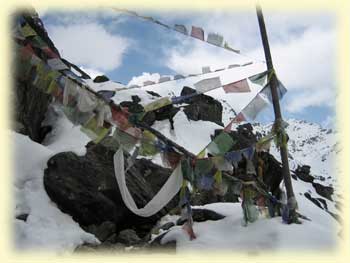 As
we descend, we see someone sitting on a mound next to the path.
It's one of our kitchen-boys. He's climbed up to us with a flask
of hot lemon, and some cheese and biscuits. To say that this is
welcome is an understatement! We drop our packs and tuck in. It's
a great place for a break, sitting on the rocks and surrounded by
snow. This snack perks me up no end, and I'm now feeling full of
energy. I dash off ahead, and have great fun sliding down the steep
sections of path. Eventually I reach the lake shore, where the path
levels out before entering the village of Gosainkund, which is perched
just above the lake. As
we descend, we see someone sitting on a mound next to the path.
It's one of our kitchen-boys. He's climbed up to us with a flask
of hot lemon, and some cheese and biscuits. To say that this is
welcome is an understatement! We drop our packs and tuck in. It's
a great place for a break, sitting on the rocks and surrounded by
snow. This snack perks me up no end, and I'm now feeling full of
energy. I dash off ahead, and have great fun sliding down the steep
sections of path. Eventually I reach the lake shore, where the path
levels out before entering the village of Gosainkund, which is perched
just above the lake.
Our lunch is set out on a wooden table, oustide a tidy-looking
lodge overlooking the lake. We make light work of lunch, while gazing
out over the magnificent lake, but as we finish, the clouds come
in, and it starts to snow again. We go inside the lodge and make
ourselves comfortable around the stove. Out of the window, we can
just make out the Israelis and the Fins, walking along the path
at the other end of the lake. I'm relieved to see them. I've heard
that people have become lost here in the past, and I can imagine
how difficult it would be to find the way down from the pass in
poor visibility. They soon arrive, safe and sound, although a little
damp. The Fins go to the lodge next door and the Israelis join us
by the fire.
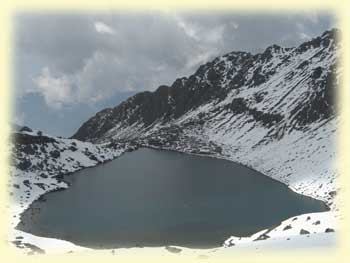 We
all sit around the stove, chatting and drinking tea. Ohren and Ehrez
hang up their wet clothes, and prop up their sodden shoes to dry
by the fire. Khukri has claimed the best spot, curled up at our
feet. He's nice and warm, and strategically placed in case any biscuits
are on offer. He looks as tired as we are. I wonder if dogs suffer
from the altitude? At least he doesn't have to dry his boots! We
all sit around the stove, chatting and drinking tea. Ohren and Ehrez
hang up their wet clothes, and prop up their sodden shoes to dry
by the fire. Khukri has claimed the best spot, curled up at our
feet. He's nice and warm, and strategically placed in case any biscuits
are on offer. He looks as tired as we are. I wonder if dogs suffer
from the altitude? At least he doesn't have to dry his boots!
We've been on the go for about seven hours now. Our planned camp
at Sing Gompa is another four hours away. Because it's still snowing
quite heavily outside, we decide to stay here for the night, rather
than continuing. The terraced fields, set aside for camping-groups,
are covered in deep snow, so Nurbu decides to set our tents up on
the lodge-patio, which has been kept clear by the lodge owners.
The location overlooks the lake and surrounding mountains. Talk
about a room with a view!
Ohren, the younger of the two brothers, isn't at all well. He's
lethargic and feeling nauseas. He has symptoms of altitude sickness,
and we suggest that he really should try so descend to the next
village. His guide agrees, but Ohren isn't keen, and insists on
staying put. Liz encourages him to drink plenty and try to eat some
plain boiled rice. He manages to drink and eat a little, and to
everyone's relief, starts to feel better.
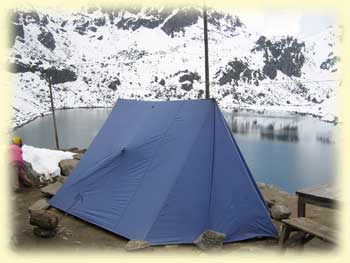 A
French Canadian guy joins us by the fire. He's going the opposite
way to us, and is on his way back to Sundarijal, having visited
the Langtang valley. He's travelling on a low budget, staying with
local people when possible. He has plenty of stories, including
how he got very sick after drinking water from Gosainkund Lake!
I can't imagine why anyone would risk that. The lake is used for
religious rituals which surely must include, ritual bathing, and
possibly the casting of sacrifices into it. Apparently thousands
of pilgrims visit the lake each year! He tells us how he got lost
at one point and while wandering through a bamboo forest came across
a red panda. It sounds like they were both equally surprised by
the encounter. A
French Canadian guy joins us by the fire. He's going the opposite
way to us, and is on his way back to Sundarijal, having visited
the Langtang valley. He's travelling on a low budget, staying with
local people when possible. He has plenty of stories, including
how he got very sick after drinking water from Gosainkund Lake!
I can't imagine why anyone would risk that. The lake is used for
religious rituals which surely must include, ritual bathing, and
possibly the casting of sacrifices into it. Apparently thousands
of pilgrims visit the lake each year! He tells us how he got lost
at one point and while wandering through a bamboo forest came across
a red panda. It sounds like they were both equally surprised by
the encounter.
After a hearty meal in the lodge dining room, we feel sleepy,
and so go off to our tent. As we emerge into the cold night air,
we are greeted by another thunderstorm raging over the mountains.
We stand and watch the spectacular light-show, which reflects back
at us from the surface of the lake below.
Some interesting notes about Gosainkund
Being the subject of legend, Gosainkunda (the lake) has numerous and varied stories attached to it. A few minutes searching on the internet will tell you all you ever wanted to know, and more! Here, I’ve distilled some of the bits that I found interesting and amusing. The story of its formation is just wonderful! (No guarantees on accuracy though!)
At the time of creation, Shiva, along with the other deities, was involved in a project to make some ambrosia. This was quite important to them, because it held the key to the secret of immortality. The recipe involved churning the sea with liquid gold, herbs, and the sap from the divine trees of Mount Meru. Alas, the churning failed to make any ambrosia. After so much hard work everyone started to flag, so Brahma, the chief god, asked Vishnu to get cracking, and reinvigorate them all. Vishnu duly obliged. Loads more churning went on, and as a by product of their efforts, the moon, the sun, the goddess of wine, and the Kaustubha Gem were formed. Vishnu was given the gem as a token of thanks for the reinvigoration. Still no ambrosia though!
More churning ensued, but this time they really put their backs into it, and churned at eleven on the churnometer. Still no ambrosia, but this time the dreaded Kalukata poison was formed, and this threatened the whole show. The demons wanted to have a go at the poison, but Shiva swallowed it before they could get their hands on it. The poison burned his throat and turned it blue. He urgently flew up to Gosainkund and stuck his Trident into a rock to let the snow melt flow. This formed Gosainkund lake, which he then drank in order to soothe his poor blue throat.
Meanwhile back at the churning, the ambrosia has at long last formed, and the demons are trying to get in on the act again. This time the hero is Vishnu, who has a cunning plan. He tricks them by appearing as a beautiful woman, and they fall for it. (Always worth a try!) In the end Vishnu ends up as the keeper of the ambrosia; quite rightly in my opinion.
There are supposedly 108 lakes in the vicinity. We saw quite a few, but not that many. Gosainkunda flows into the Trisuli River, named after Shiva’s trident, which is more correctly known as a trishul. The source of the lake, where Shiva shoved his trishul, is bedecked in flags, as befits its special place in the legend. The rock protruding from the lake is said to be Shiva's head.
There's another story about a devout Hindu pilgrim who dropped his brass water vessel, while bathing in the lake. It sank, and later appeared in the Khumbheshowr temple, at Patan, in the Kathmandu Valley. This lead to the belief that there is a channel from the lake to the temple, and this is borne out by the fact that the pond is unusually cold even in the summer. Some people who can't make the trip to Gosainkund will visit the Khumbheshowr temple instead.
As a pilgrimage site, Gosainkunda is one of the most important in the country. Pilgrims visit in their thousands, coming mainly from Nepal and India. There are two occasions each year. The first, called Jeshtha Shukla Dashamee is in June. The name means the tenth day of the bright fortnight. On this occasion, bathing in the lake, and offering worship, is believed to cleanse the pilgrims of their sins.
The second pilgrimage, called Janai Poornima or Rishi Panchamee, takes place at the full-moon around mid-August. Here adult male Brahmins and Chhetris, who wear the sacred thread (Janai), replace it with a fresh one. This is blessed by a priest who is given money. Raksha Bandhan is also performed on the same day. This involves tying a cotton thread around the wrist for protection, and showing respect to Rishis for their holy deeds. Pilgrims are required to fast and then later eat a vegetarian meal. I’ve read that recently, 8,000 pilgrims visited for this ceremony. When you are there with just a handful of people, as we were, such crowds are hard to imagine.
One of the most interesting bits of information I came across, was in an article in the BMJ (British Medical Journal), by Buddha Basnyat, on Pilgrimage Medicine. Dr Basnyat talks about the medical aspects of joining pilgrimages in general, and the special hazards of travelling to Gosainkunda in particular.
Many of the pilgrims are not in the best of shape to attempt what is, in effect, a strenuous high altitude trek. Some of them are fasting and not even drinking water, and some are also overweight and unfit. Lots of them are adhering to a schedule which forces them to go too high too quickly. The inevitable altitude sickness suffered by many, is attributed by some to the effects of the scent from the flowers by the pathway. No doubt any hallucinatory effects from cerebral oedema, are attributed to divine revelation!
It's easy to see the conflicting forces at play in such a pilgrimage. Religious zeal encourages unprepared and unfit people, to visit a place, which by virtue of its location can threaten their very lives. The option of turning back, when affected by the altitude, must be a very difficult one to take for many of them. The hardship and illness must be seen by many as part of the price that needs to be paid for the benefits believed to be on offer.
Add to this, the difficulty in maintaining food hygiene, in overcrowded overnight stops, and you can understand how each year, many people fall ill and even die on their journey to this holy place. Dr Basnyat’s message is that more needs to be done to educate pilgrims in the hazards that they face, in the hope of reducing the suffering. Certainly we saw some very clearly worded signs giving very good advice to travellers. Also, the frequency and quality of accommodation along the trail should, hopefully, tempt some people into taking the climb a bit more steadily.
As an amusing side note; some pilgrims report that leeches are not as much of a problem as one might have expected. The theory is that, with such a massive influx of pilgrims, there just aren’t enough leeches to go round!
Dr Basnyat’s Article
An amusing account of the Gosainkund legend, from Ian Johnson’s excellent YetiZone
<Next>
<Return to Nepal Page>
© Roy L Richards 2012
Contact for problems, queries etc:
|
Updated Jan 2010
|
|
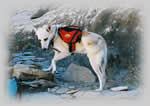
|
|
|
|

|
|
|





